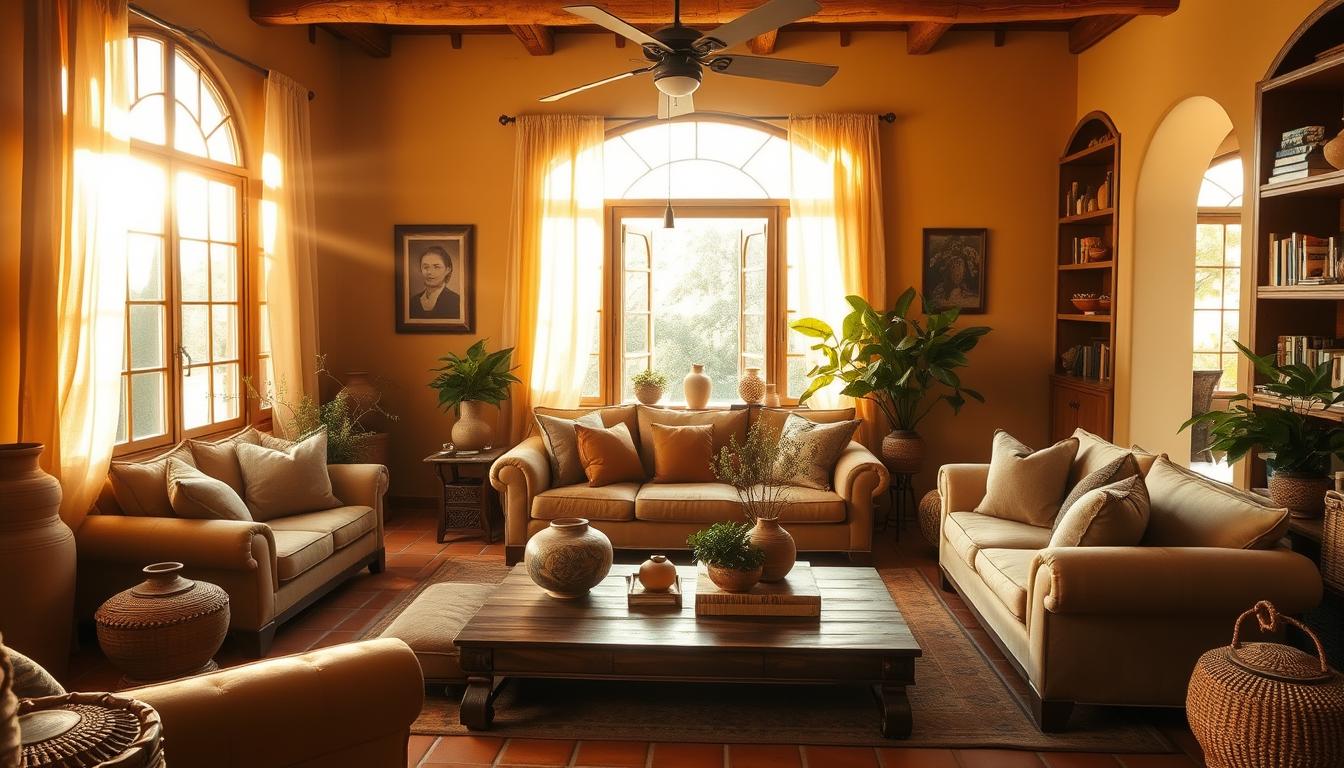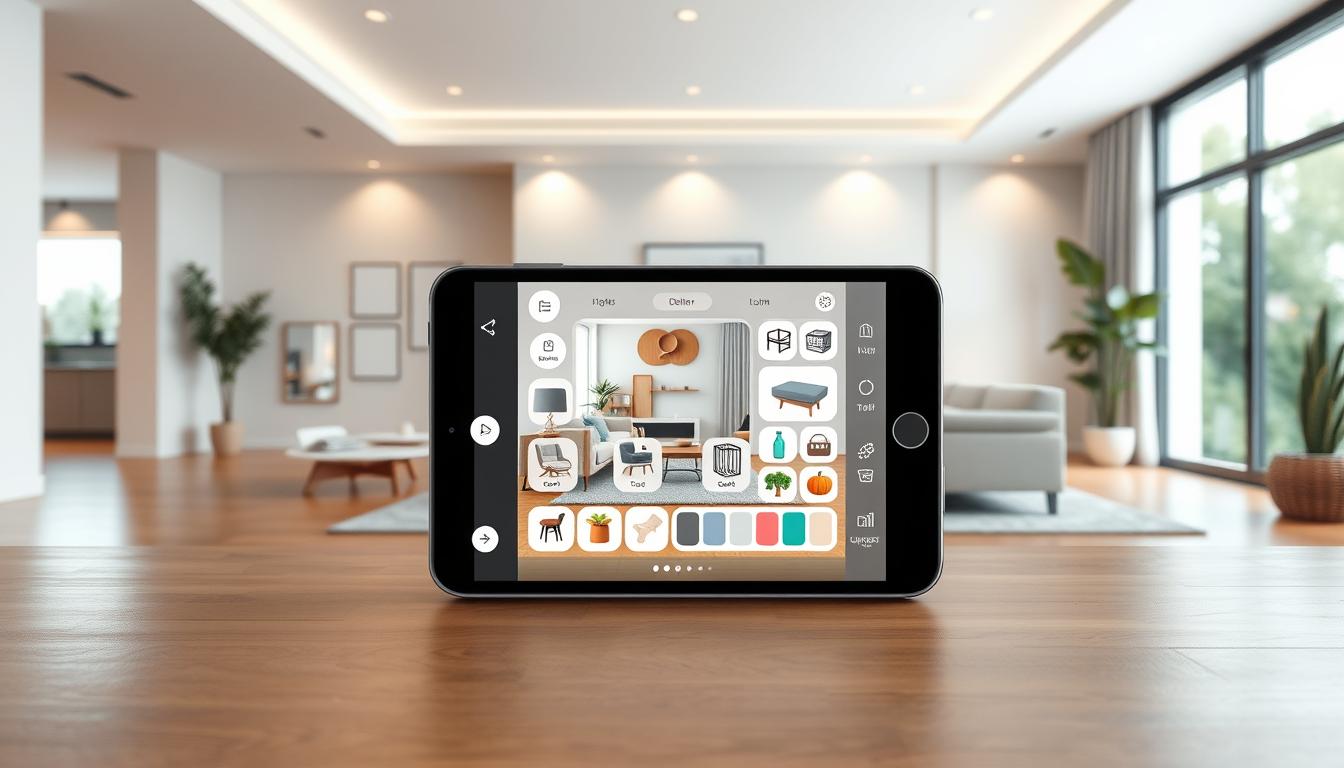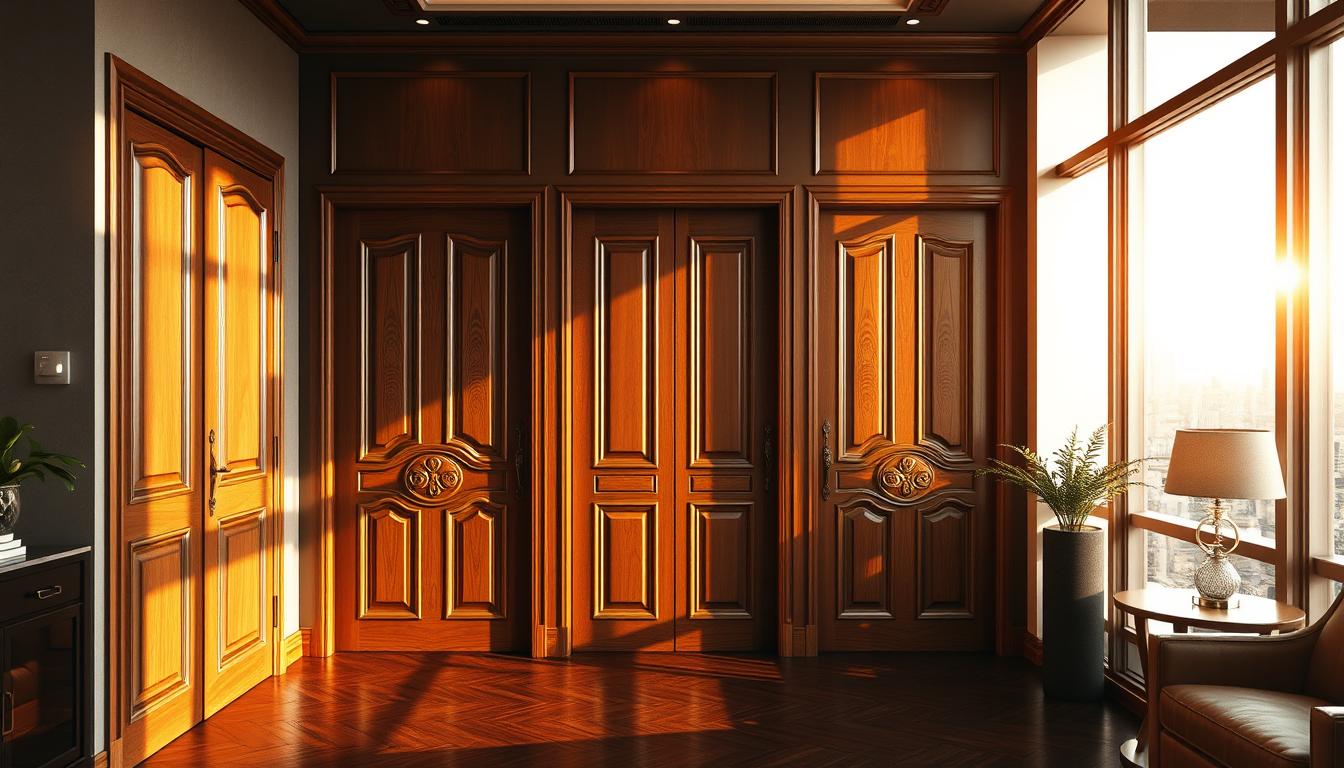Spanish style is making a big comeback in interior design. It’s winning hearts with its warm and lasting look. This style blends old traditions with Mediterranean decor, making it a favorite in today’s homes.
We’re thrilled to share the key features of this stunning style. You’ll see inspiration photos and get tips on adding it to your home. Our guide will take you through the history and growth of spanish style homes interior design. We’ll show you what makes it so charming.
Key Takeaways
- Understanding the history and evolution of Spanish-style homes
- Identifying key characteristics of Mediterranean decor
- Learning how to incorporate this style into your home
- Discovering inspiration photos and practical tips
- Exploring the timeless appeal of this aesthetic
Introduction to Spanish Style Homes
Spanish style homes have a charm that’s both elegant and cozy. They draw from Mediterranean architecture. This style is warm and inviting, showing off the natural beauty of the Mediterranean.
What Defines Spanish Style?
Spanish style homes use neutral earth tones for a calm look. These tones are then brightened by pops of colorful accents. This adds vibrancy and character.
Architectural elements like arches and curves add elegance. Tile work, like hand-painted tiles, is also key. It brings a unique, personal touch.
Key Features We Love
Spanish style homes are known for their warm and inviting atmosphere. They use natural materials and earthy tones. This creates a cozy feel.
The style also focuses on outdoor living spaces. Courtyards and patios make the indoors feel like outdoors. This adds to their charm.
| Feature | Description | Benefit |
|---|---|---|
| Neutral Earth Tones | Use of earthy colors like terracotta and beige | Creates a calm and serene atmosphere |
| Hand-Painted Tiles | Unique, hand-crafted tiles used for decoration | Adds a personal touch and character to the space |
| Arches and Curves | Architectural elements that add elegance and sophistication | Enhances the aesthetic appeal of the home |
These elements make Spanish style homes unique and inviting. They reflect the warmth and hospitality of Spanish culture.
Architectural Elements of Spanish Design
In Spanish interior design, architectural elements are key. They bring out the rustic charm and elegance of a home. Traditional features honor Spain’s rich culture and add warmth and sophistication to spaces.
Arches and curves are a hallmark of Spanish architecture. They add elegance and grandeur to buildings.
Arches and Curves
Arches have been a part of Spain since ancient times. They show off craftsmanship and building skills. Arches and curves are found in doorways, windows, and furniture, connecting to Spanish design’s history and culture.
“The arch is a symbol of Spanish architecture, embodying the grace and beauty that define the country’s building traditions.”
Arches and curves make modern architecture feel more organic. They balance form and function beautifully.
Tile Roofs and Decorative Facades
Tile roofs are a key feature of Spanish architecture. They protect from the weather and look great. Terracotta tiles add a warm, earthy look that fits well with nature.
Decorative facades, with intricate carvings or tile work, enhance Spanish homes’ beauty. These details show off the builders’ skill and tell stories of the past.
| Architectural Element | Description | Contribution to Spanish Design |
|---|---|---|
| Arches and Curves | Elegant, flowing shapes used in doorways, windows, and decorative elements. | Adds a sense of history and cultural depth. |
| Tile Roofs | Terracotta or ceramic tiles used for roofing, providing weather protection and aesthetic appeal. | Brings warmth and a natural, earthy tone to the exterior. |
| Decorative Facades | Intricately carved stone or ornate tile work adorning the exterior of buildings. | Enhances the visual appeal and tells a story of cultural heritage. |
Using these architectural elements, homeowners can make a space that’s both beautiful and deeply connected to Spanish design.
Color Schemes in Spanish Interiors
Color schemes are key in Spanish interior design. They make spaces cozy and welcoming. The right colors can take you to Spain’s sunny landscapes, bringing warmth and hospitality.
Spanish interiors mix warm earth tones with bold colors. Warm earth tones like terracotta and deep reds are the base. They add comfort and authenticity.
Warm Earth Tones
Terracotta, ochre, and deep reds reflect Spain’s rich history. These colors are paired with wood and stone for a cozy feel.
In homes with Moorish design, you’ll see jewel tones like blue and green. These colors add luxury and sophistication. They’re used sparingly for interest and depth.
Bold Accent Colors
Bold colors add personality to Spanish interiors. Mustard yellow and other bright hues contrast with earth tones. They bring energy and vibrancy.
In modern Spanish decor, these colors get a fresh twist. By mixing warm tones with bold colors, homes become unique and captivating. They honor Spanish style while being modern.
- The architectural style of your home
- The natural surroundings and landscape
- The desired ambiance and mood
By combining warm earth tones with bold colors, you create a stunning and authentic color scheme.
Furniture Choices for Spanish Style Homes
Spanish colonial interiors are known for their rich textures and ornate details. Choosing the right furniture is key. It shows the home’s character and heritage.
To make a Spanish-style home, we focus on furniture that shows traditional craftsmanship and elegance. Rustic wood and elegant wrought iron are key elements.
Rustic Wood Pieces
Rustic wood furniture adds warmth and history to Spanish-style homes. Wooden beams and heavy, ornate furniture are common, made from durable woods like oak or walnut. These pieces are both functional and decorative, enhancing the home’s rustic charm.
The tradition of using rustic wood in furniture making goes back centuries. It reflects the craftsmanship and simplicity of earlier times. Adding such pieces brings depth and authenticity to our Spanish-style interiors.
Elegant Wrought Iron
Wrought iron has been a key feature in Spanish architecture for centuries. It adds an elegant and sophisticated touch to furniture, like console tables, chandeliers, and decorative accents.
Wrought iron’s versatility lets it be shaped into intricate designs. It’s perfect for adding ornate details to our furniture. By using wrought iron, we can enhance our homes’ Spanish style, making them more inviting.
In conclusion, the right furniture choices are crucial for capturing the essence of Spanish colonial interiors. Combining rustic wood pieces with elegant wrought iron creates a rich and inviting home environment. It honors the traditional Spanish style.
Flooring Options in Spanish Design
Spanish interior design is known for its flooring, blending traditional materials with elegance. The right flooring can take you to Spain’s sunny landscapes. It brings the warmth and hospitality of Spanish culture into your home.
Terracotta and Saltillo Tiles
Terracotta tiles are a key feature of Spanish architecture. They offer a traditional and rustic look that fits well with Spain’s culture and climate. These tiles are made from natural clay, giving them a unique, earthy charm.
Saltillo tiles, a type of terracotta, are very popular in Spanish design. They have warm, earthy tones that make rooms cozy and inviting. Design experts say, “Terracotta tiles bring a sense of authenticity and warmth to any room.” For more ideas on using Spanish tile flooring, visit Spanish Tile Flooring Ideas.
Hardwood and Carpeting
While terracotta and Saltillo tiles are common, hardwood and carpeting also play a role in Spanish villa design. Hardwood floors add sophistication and elegance, perfect with traditional Spanish furniture.
Carpeting adds warmth and texture to a room. In Spanish design, vibrant, colorful rugs are common. They add color and create a cozy atmosphere. Each material has its own benefits and drawbacks, allowing homeowners to choose the best for their Mediterranean decor.
In conclusion, the flooring in a Spanish-style home is crucial. It can make or break the look. By picking the right materials and designs, homeowners can create a warm, inviting space that reflects Spanish culture’s beauty and charm.
Decorative Details That Capture Spanish Flair
Decorative details are key in Spanish style homes. They show the culture and history of this style. These elements make a room look authentic and welcoming.
Hand-painted tiles are a standout feature. They have Moorish and Islamic designs, adding history and art to the home. We can use them in kitchens, hallways, and bathrooms.
Hand-Painted Tiles
Hand-painted tiles come from Spain’s Moorish past. Each tile shows the artist’s skill. We can use them in many ways, like:
- As a focal point in a fireplace
- To frame a room or hallway
- On tabletops or countertops for a unique look
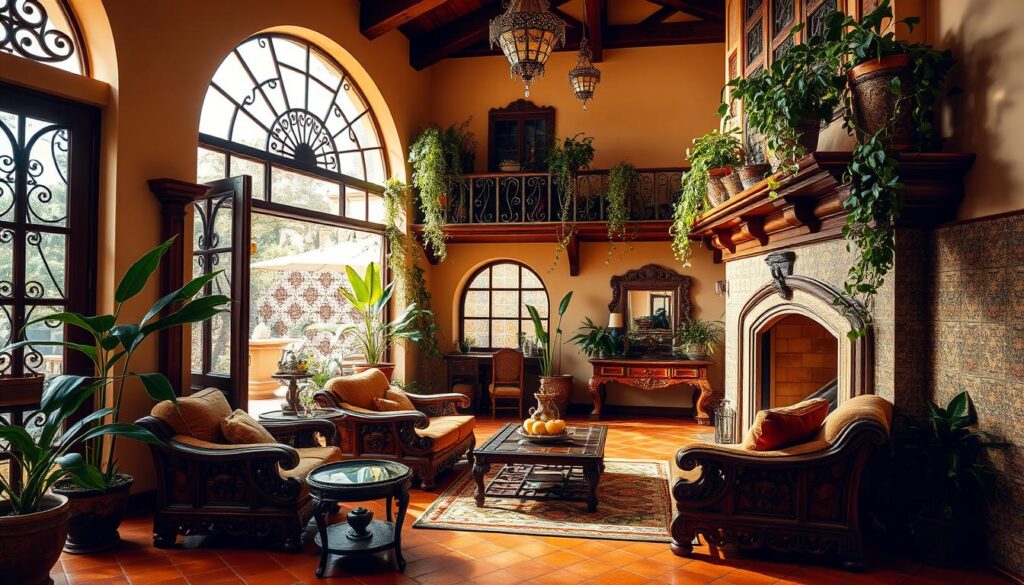
Textiles and Fabrics
Textiles and fabrics are vital in Spanish home design. Velvet, silk, and wool add warmth and texture. We draw inspiration from traditional Spanish textiles.
To enhance the Spanish look, we use textiles with intricate patterns on furniture and decor. These elements add color and texture, making the space cozy. By mixing these details, we blend traditional Spanish style with modern comfort.
Creating Cozy Spaces in Spanish Homes
Spanish homes are known for their cozy and welcoming feel. This is thanks to a mix of textures and layouts. We’ll look at how to make these cozy spaces by using organic textures and layouts that bring people together.
Textures That Warm the Space
Spanish design is famous for its warm feel, thanks to different textures. Using plaster, clay, woven fibers, leather, iron, and wood adds depth and character. These textures not only look good but also feel great, making a space feel cozier.
Adding rustic wooden beams and wrought iron accents brings warmth and authenticity. Hand-painted tiles and terracotta flooring add earthiness, making the space feel cozy and grounded.
Layouts That Encourage Gathering
The layout of a home is key to creating a cozy atmosphere. Spanish homes often have layouts that encourage people to gather. This is done by arranging furniture to promote conversation and togetherness.
| Layout Element | Description | Benefit |
|---|---|---|
| Central Courtyard | A central open space that connects various rooms | Encourages family gatherings and social interaction |
| Cozy Nooks | Small, intimate spaces with comfortable seating | Provides a quiet retreat for relaxation |
| Large Dining Areas | Spacious dining rooms that can accommodate large groups | Fosters a sense of community during meals |
By mixing textures and designing layouts for gathering, we can make Spanish homes cozy and inviting. This approach respects traditional Spanish design while adding modern touches. It creates a unique and welcoming living space.
Outdoor Living in Spanish Style
Outdoor living is key in Spanish-style homes. Courtyards and patios are central to the design. They blend indoor and outdoor spaces, creating a welcoming atmosphere.
Courtyards and patios are heart of Spanish homes. They offer a calm oasis in busy areas.
Courtyards and Patios
Courtyards and patios use warm materials like terracotta, stone, and brick. These materials add beauty and warmth.
Greenery and flowers make these spaces even more inviting. They bring nature and peace. The right plants can change the mood, making them great for relaxing or parties.
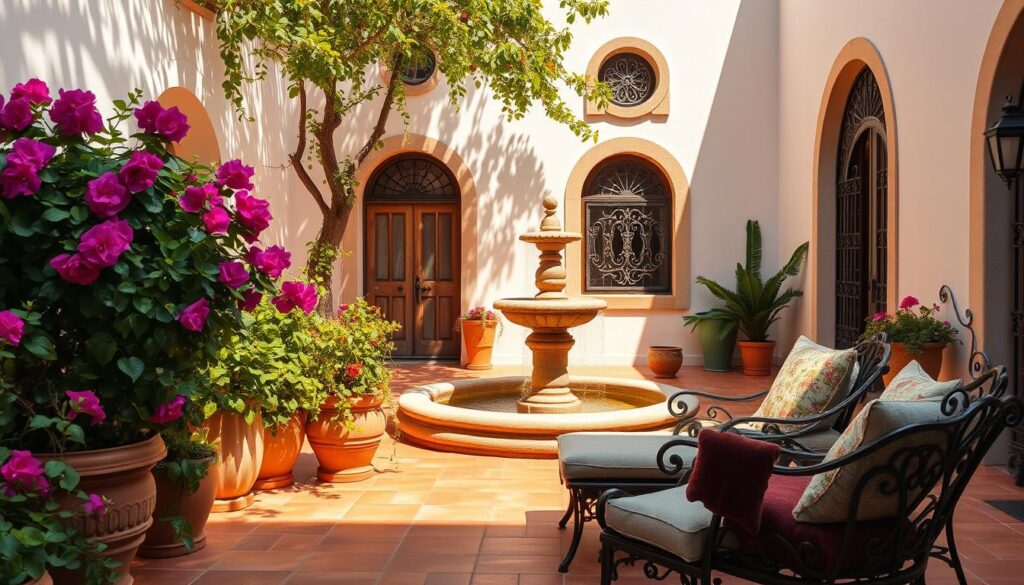
Incorporating Nature
Spanish homes blend nature into outdoor spaces. This is done with natural materials, water features, and plants.
Outdoor areas can feel like part of the home. They’re perfect for meals, parties, or just enjoying the fresh air. Natural elements connect indoor and outdoor spaces.
| Feature | Description | Benefit |
|---|---|---|
| Courtyards | Central open spaces surrounded by the home | Provides a private, tranquil area |
| Patios | Outdoor areas often adjacent to the home | Ideal for dining and social gatherings |
| Natural Materials | Use of terracotta, stone, and brick | Adds warmth and coziness to the space |
Designing outdoor spaces well makes living better. It’s about using natural materials, placing plants wisely, and adding water features. Spanish homes offer a special outdoor living experience.
Lighting Solutions for Spanish Interiors
Lighting is key in Spanish villa interior design. It can make the whole space feel warmer and more welcoming. The right lighting can really bring out the charm of Spanish interiors.
We’ll look at two important parts of lighting in Spanish interiors. These are statement fixtures and soft ambient lighting. Both are vital for a balanced and true Mediterranean decor.
Statement Fixtures
Statement lighting fixtures are a big part of traditional Spanish design. They often have wrought iron and hand-forged elements. These fixtures light up the space and also decorate it, adding to the room’s look.
Some popular statement fixtures include:
- Chandeliers with intricate metalwork
- Sconces with ornate details
- Pendant lights with handmade glass shades
Soft Ambient Lighting
Soft ambient lighting is also key for a cozy feel in Spanish interiors. It balances the boldness of statement pieces and adds warmth. This type of lighting makes the space feel more inviting.
To get soft ambient lighting, try using:
- Table lamps with soft shades
- Floor lamps with dimmable capabilities
- String lights or fairy lights for a whimsical touch
By mixing statement fixtures with soft ambient lighting, you get a layered lighting effect. This enhances the beauty of your Spanish villa interior design.
Bringing Modern Touches to Spanish Style
Modern Spanish-style homes mix old and new to look fresh and updated. When we talk about spanish style homes interior design, adding modern touches is crucial. It makes these spaces feel both classic and contemporary.
Blending Contemporary Elements
To add a modern twist to Spanish style homes, we can use sleek lighting, simple decor, and the latest tech. We can also keep traditional features like arches, tile roofs, and wrought iron.
Innovating While Honoring Tradition
By mixing new ideas with old traditions, we create a special interior design. It respects Spanish style’s rich history while offering modern comforts. This mix makes for an amazing living space.

